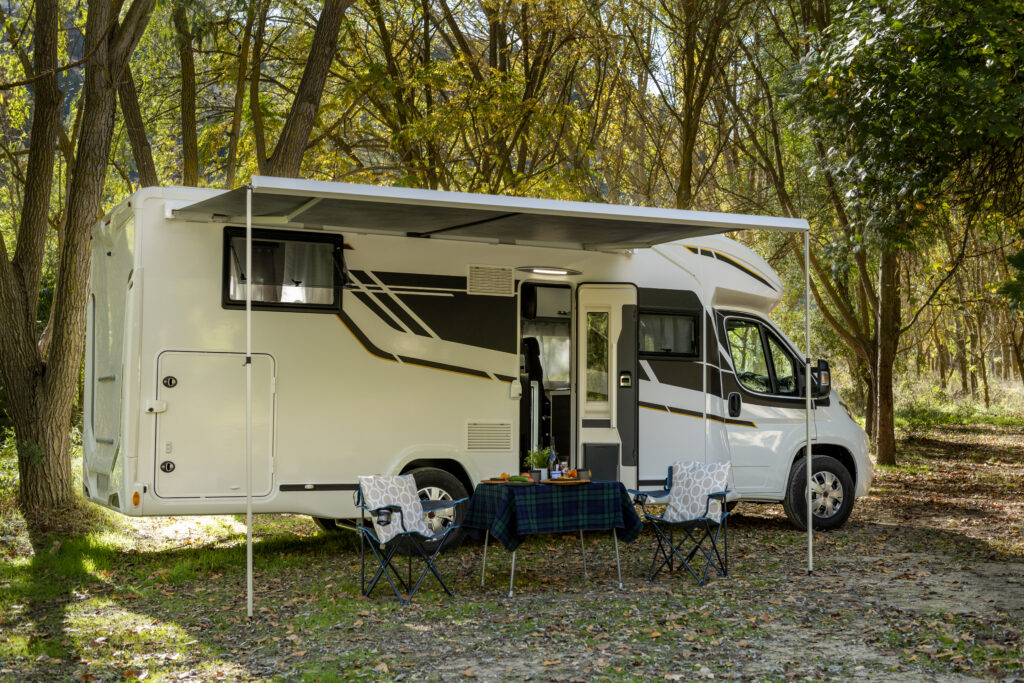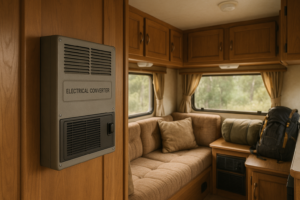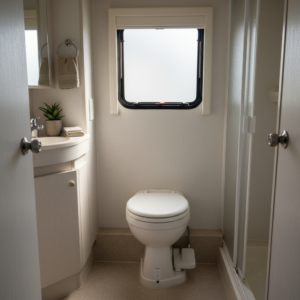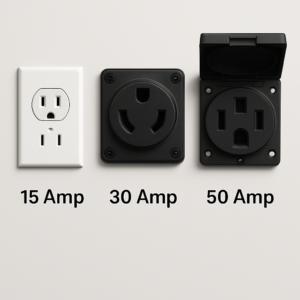
Types of RV Awnings & How To Choose the Best One
Table of Contents
Ask any seasoned RVer what makes a great campsite, and chances are they’ll point to their awning. RV awnings may seem like simple add-ons, but they do more than just create shade. They transform your RV into a comfortable living space, protect your rig from the elements, and even extend the lifespan of the exterior. The tricky part is choosing the one that works for your unique requirements. From manual rollouts to fully automatic setups with wind sensors and LED lighting, the types of RV awnings available today give you a host of options.
If you’ve ever stood in a dealership or scrolled through a parts catalog wondering whether vinyl is better than acrylic, or whether you really need a motorized option, you’re in the right place. In this guide, we’ll break down the different RV awning types, their pros and cons, how to decide what works best for your lifestyle, and what to keep in mind for maintenance and long-term care.
Why RV Awning Choice Matters
An RV awning is more than just a convenience. It is an investment that transforms your experience on the road. Picture pulling into a Florida campground in July. Without an awning, your rig bakes in the sun, your AC runs overtime, and stepping outside feels like walking into an oven. Now imagine unrolling a sturdy awning – instant shade, cooler interiors, and a breezy outdoor space where you can sip your morning coffee.
Beyond comfort, awnings also protect your RV. They shield windows and slide-outs from UV rays, keep rain from pooling near seals, and help prevent long-term weathering of your siding. Choosing the wrong type of awning, though, can lead to headaches, such as mildew-prone fabrics in humid regions or manual setups that feel like a chore every time you stop. Getting it right means better protection, less hassle, and a setup that fits your travel style.
Types of RV Awnings
We have classified RV awnings based on the following factors:
1. By Mechanism
Manual/Winch Awnings
These are the classic hand-crank or pull-rod awnings that many RVers start with. They’re simple, reliable, and don’t require electricity.
- Pros: They are budget-friendly, lightweight, and have fewer parts that can break. Perfect if you don’t mind a little elbow grease.
- Cons: They require physical effort and can be tricky to manage in windy conditions. If you’re older or have mobility challenges, the constant setup and takedown can become tiring.
Electric/Automatic Awnings
For many RVers, especially full-timers, this feels like a luxury that quickly becomes a necessity. With the push of a button or a remote control, your awning extends smoothly. Many newer models even come with wind sensors that retract the awning automatically during storms.
- Pros: Convenience, modern features (like integrated LED lights), and consistent deployment.
- Cons: More expensive, and if the motor fails, you’ll need repairs. They also draw from your RV’s power system.
Retractable Awnings (Manual & Motorized)
Retractable awnings offer flexibility with protection. You can extend them partially or fully, depending on how much coverage you need. Both manual and electric versions exist.
- Advantages: Adaptable to changing weather. For example, in breezy coastal spots, you can extend them halfway to reduce wind stress.
2. By Installation Type or Purpose
Fixed Awnings
These are permanently mounted and always in place. You’ll often see them on older rigs or park models that don’t move often.
- Pros: Always ready, extremely durable.
- Cons: No flexibility as you can’t retract them while driving, and if they get damaged, repairs can be costly.
Slide Out Awnings (Slide Toppers)
Slide toppers protect the tops of your RV slide-out from debris, rain, and UV rays. Though they may not be glamorous, they’re vital for protecting seals and mechanisms.
- Pros: They prevent water from pooling, keep dirt from jamming your slide system, and block heat from the sun—helping your RV stay cooler and improving A/C performance.
- Cons: They’re an extra expense and may require after-market installation.
Patio/Sheltered Awnings
Think of these as your mobile porch. They can include walls, screens, or even doors to create an enclosed outdoor room.
- Pros: Expands your living space and is great for families or snowbirds who spend months in one spot. They also add privacy.
- Cons: More complex to set up, often requiring support poles. Ventilation can be poor on hot days.
Window & Door Awnings
These smaller awnings are installed above windows or entry doors to block the sun and rain. They may seem like a small detail, but they can make a big difference on long trips.
- Pros: Reduce glare, cut interior heat, and keep rain from dripping at windows or doors.
- Cons: Provide limited coverage compared to larger awnings and add extra maintenance points.
3. By Material
Acrylic Fabric
This breathable fabric allows air to circulate, keeping the shaded area cooler. It dries quickly, which is a plus in humid regions.
- Pros: Great for hot, dry climates. Resistant to fading.
- Cons: Not fully waterproof, so heavy rain can seep through. Over time, it may stretch.
Vinyl Fabric
Vinyl is the workhorse of awning fabrics. It’s fully waterproof and handles UV exposure well.
- Pros: Durable, low-maintenance, excellent for rain protection.
- Cons: Attracts mold and mildew if rolled up damp. It can also trap heat, making it less comfortable in sweltering weather.
Canvas
Canvas is less common today but still used for slide-out toppers and lightweight awnings.
- Pros: Lightweight, easy to clean, budget-friendly.
- Cons: Not waterproof, prone to pooling water, and less durable in the long term.
How To Choose the Best RV Awning for You
Your best awning depends on how and where you travel.
- Usage & convenience needs: If you’re a weekend camper, a manual retractable awning may be fine. But if you’re a full-timer who wants quick shade at every stop, go for an electric retractable model.
- Weather resistance: Traveling the Pacific Northwest? Vinyl’s waterproofing will serve you better. Heading to Arizona or Nevada? Acrylic will breathe better in dry heat.
- RV configuration: Do you need slide-out protection, window shading, or just a large patio space? Match your awning to your rig’s design.
- Budget & maintenance: Factor in not just the purchase price but upkeep. Cheaper RV awning types may wear faster, while premium ones often last longer with less hassle.
- Installation & mobility: If you move often, retractable is best. If you’re mostly stationary, fixed or patio awnings might be worth the investment.
A Quick Decision Table
| Your Need | Recommended Type |
|---|---|
| Easy, push-button operation | Electric / Automatic Retractable |
| Budget-friendly, simple | Manual / Winch Retractable |
| Protect slide-outs | Slide Out Awning (Slide Topper) |
| Create extra outdoor living area | Patio / Sheltered Awning |
| Permanent shade while stationary | Fixed Awning |
| Reduce glare through windows | Window / Door Awnings |
When To Repair or Replace an RV Awning
Like any part of your RV, awnings don’t last forever. But not every issue means you have to replace the whole thing. In many cases, minor, localized problems can be repaired at a fraction of the cost of a complete replacement.
When Repairs Usually Make Sense:
- Small fabric tears or punctures (less than a few inches) are often fixable with repair tape or a fabric kit.
- Stitching or seam separation is usually repairable with re-stitching or sealant.
- Minor hardware issues, such as a loose arm, broken spring, or bent support bracket, can often be replaced individually.
- Motor hiccups in electric awnings are sometimes caused by worn gears, switches, or wiring, which a technician can replace without changing the entire system.
- Discoloration or light mildew can often be removed with deep cleaning, especially if caught early.
When Replacement is the Smarter Move:
- If the fabric is brittle, cracked, or severely faded, patches won’t hold, and the material will continue to break down.
- Widespread mold or mildew that won’t wash out is a health and longevity risk.
- Bent or rusted frames compromise structural integrity, making repairs unsafe or short-lived.
- The awning fails to extend or retract smoothly, even after mechanical repairs.
On average, RV awnings last 5–15 years, depending on use and care. If yours is reaching the end of that range, or has seen heavy use in tough climates, you can reach out to our RV awning replacement and installation experts and save money (and headaches) in the long run.
Self-Installation vs. Professional: Which Route to Take?
If you’re handy, you might be tempted to install or replace an awning yourself. However, choosing a professional installer can often save you more time and stress in the long run.
- Cost & time: Attempting to install the awning yourself can stretch over several days. A pro can finish the job in just 3–5 hours.
- Skill, tools & quality: Professional installers have the right tools to align the awning, set correct tension, and ensure seals won’t leak. Improper installation can lead to issues that might void warranties.
- Durability: Professionally installed awnings typically last 5–7 years longer. Technicians ensure the frame is properly aligned, the tension is set correctly, and the seals are fully watertight.
- Safety: Motorized systems involve wiring, and large awnings can be heavy and awkward. If you don’t have help, it’s risky.
When to Seek Professional Help
Call an expert if:
- You’re installing an electric/automatic awning with wiring and sensors.
- You’re adding a fixed or patio awning that may need structural reinforcement.
- Your motor has failed, or the arms are bent.
This is where mobile RV services from Good Sam RV ProCare come in handy. Certified technicians can come directly to your campsite, whether you’re parked at a Florida resort or a Washington forest campground, saving you the stress of hauling your rig to a shop.
RV Awnings Maintenance & Best Practices
Want your awning to last as long as possible? A little routine care is what’s needed:
- Always let the fabric dry thoroughly before rolling it up.
- Clean it regularly with mild soap and water. Avoid harsh chemicals that break down coatings.
- Inspect seams, mounting hardware, and arms for signs of wear.
- If your awning has wind or sun sensors, test them before each season.
Conclusion
Choosing the right awning is more than picking fabric or color. It’s about matching the type of awning to how you camp, where you travel, and how much convenience you want. Whether you’re a retiree chasing warm winters in the South or a family taking weekend trips up the coast, the right awning transforms your RV into a more comfortable, protected, and enjoyable home on wheels.
And when it comes time to install, repair, or replace your awning, having the right partner matters. With Good Sam RV ProCare, you get professional expertise, mobile service, and peace of mind that your investment is backed by quality care.
Frequently Asked Questions (FAQs)
Which RV awning is best for full-time RV living?
Electric or automatic retractable awnings are the top pick for full-timers thanks to convenience, durability, and modern features.
What is the best type of RV awning fabric?
Vinyl is best for wet climates due to its waterproofing, while acrylic works better in hot, dry regions.
How long do RV awnings last?
Most RV awnings last between 5–15 years, depending on material, weather exposure, and maintenance.
What’s the difference between acrylic and vinyl awnings?
Acrylic is breathable and cooler in heat, but not fully waterproof. Vinyl is waterproof and durable, but can trap heat and attract mildew.


